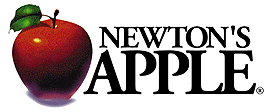

\
 |
How is an airplane fire different from a regular fire? When firefighters crash jets to practice on, how do they keep people from getting hurt? |  |
Aircraft Fire Rescue
How does a firefighter put out an airplane fire?
![]() Dave feels the heat during a simulated air crash rescue.
Dave feels the heat during a simulated air crash rescue.
Segment length: 7:00
A passenger jet has crashed. Flames shoot into the air. Dozens of people are trapped inside. How can firefighters rescue anyone in a raging inferno like that?
It takes skilled professionals with special training. That's why men and women from around the country come to the new Aircraft Rescue and Fire Fighting (ARFF) Facility in Duluth, Minnesota.
There, they practice rescue techniques in a state-of-the-art airplane crash simulator designed to replicate a Boeing 757 jet. Nearly a hundred computer-controlled nozzles in and around the simulator shoot propane gas flames. When that happens, the firefighters pump foam onto the fire. But since this is a simulator, the foam doesn't actually put the fire out-the computer turns off some of the nozzles instead.
When the fire outside is under control, firefighters cut their way through replaceable panels and into the jet's "cabin." Smoke is everywhere, so they may wear goggles equipped with IRIS (infrared imaging system). In the simulation, however, the smoke isn't real. It's hydraulic fluid that has been heated to 427oC and blown out nozzles.
If trainees don't put out the fire in two and a half minutes or less, they fail the test. That may sound like a tough challenge but if a real jet crashes and the interior begins to burn, firefighters would only have about two minutes to rescue the passengers. (Fortunately, passengers can survive most jet crashes if they follow evacuation directions given on board.)
Every effort is made to see that nothing gets hurt during training-not the firefighters, not the environment. For example, in a real crash, firefighters would use aqueous film forming foam (AFFF). The chemicals in AFFF mix with water and are "fluffed up" into a foam, but they won't mix with the fuel in a jet crash fire. This means the water can float on top of the fuel and smother the fire. AFFF creates a seal around the firefighters' boots as they try to rescue the passengers. If the foam didn't do this, the fire could flash back and endanger the rescuers as well as those being rescued.
The foam used during the simulation, however, is biodegradable dish washing soap. Once it is sprayed, it slides into a pit under the simulator where it is treated and released into the regular water treatment facility.
Connections
1. What other situations could be simulated to give people the practice
they need to face an emergency?
2. What would you include in a simulation to prepare firefighters for a
fire in a skyscraper during the middle of a working day?
biodegradable substance that can be broken down
by natural processes
FAA Federal Aviation Administration; government agency that operates
the national air traffic control system
foam mass of gas bubbles in a liquid film matrix
fuselage central body of an airplane that holds passengers, crew,
and luggage
infrared electromagnetic radiation invisible to
the human eye but detectable as heat
IRIS infrared imaging system; allows firefighters
to see heat images even through smoke
mockup scale model used for demonstration, study, or testing
propane a natural gas, C3H8, usually used to make
heat
radiative heat heat transferred from a distance. The sun and car
radiators emit this kind of heat.
simulator apparatus that gener-ates test conditions
close to real
Additional resources
Additional sources of information
Rescue Squad
Simulate a plane crash and practice saving passengers.
Time is critical in an airplane crash rescue. From the moment they arrive, firefighters have less than two and a half minutes to put out a fire and make a rescue. How many people could you rescue in a similar situation? This simulation will help you find out.
Materials
Questions
1. Do you get quicker with each simulation? What are some ways you could
improve your rescue time?
2. How do the "sighted" rescues compare with the "blinded"
rescues?
3. In what ways did you use teamwork rather than simply acting as a group
of individuals?

![]()
Wrap your hand in a "glove" you've made from aluminum foil and
then slip a big mitten over that. Slip a thermometer in next to your hand.
Record the temperature at five-minute intervals. What do you begin to feel
after the first ten minutes? Switch so that the mitten is next to your
skin and the foil is wrapped on the outside. Any differences?
![]()
Interview several firefighters and find out why they chose this job. Ask
about their "scariest" fire and find out why it was so scary.
If you can, try and find one who has had special training for fighting
jet crash fires. Ask why she or he went into this special field.
Tapes of this episode of Newton's Apple and others are available
from GPN for only $24.95.
Please call 1-800-228-4630.
For information on other Newton's Apple resources for home and school,
please call 1-800-588-NEWTON!
 We encourage duplication for educational
We encourage duplication for educational Newton's Apple is a production of KTCA Twin Cities Public Television.
Made possible by a grant from 3M.
Educational materials developed with the National Science Teachers Association.